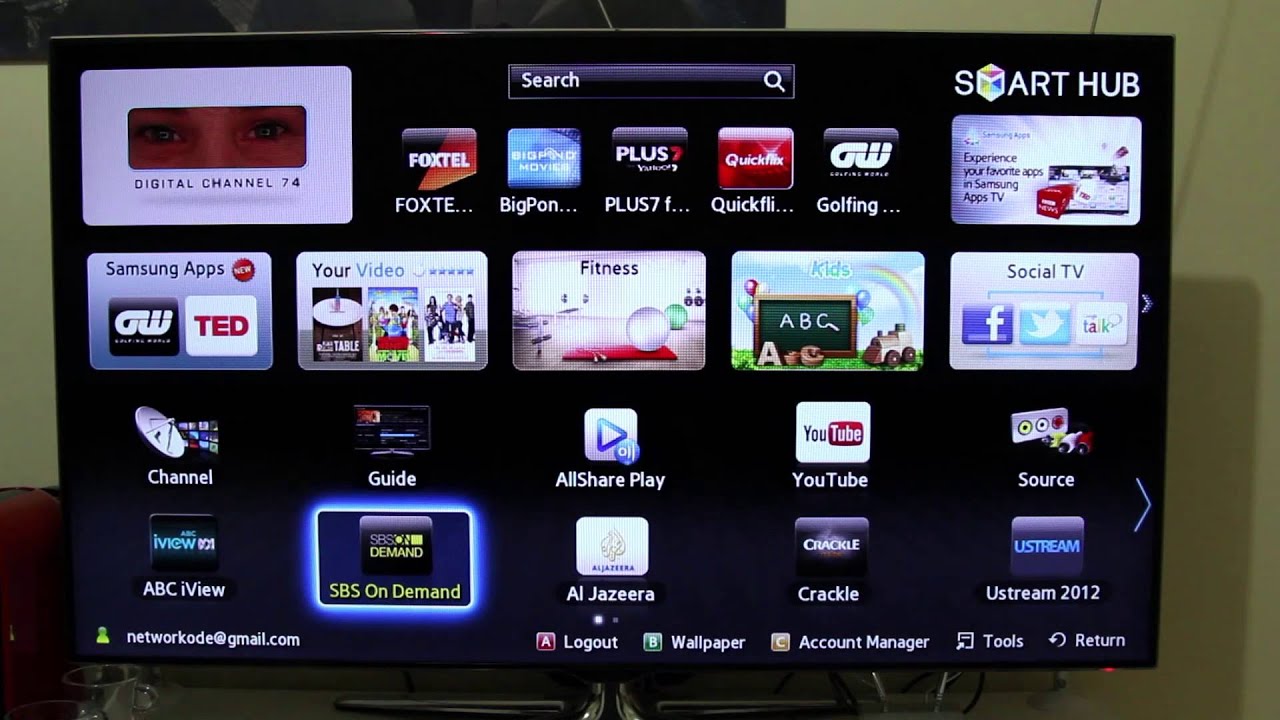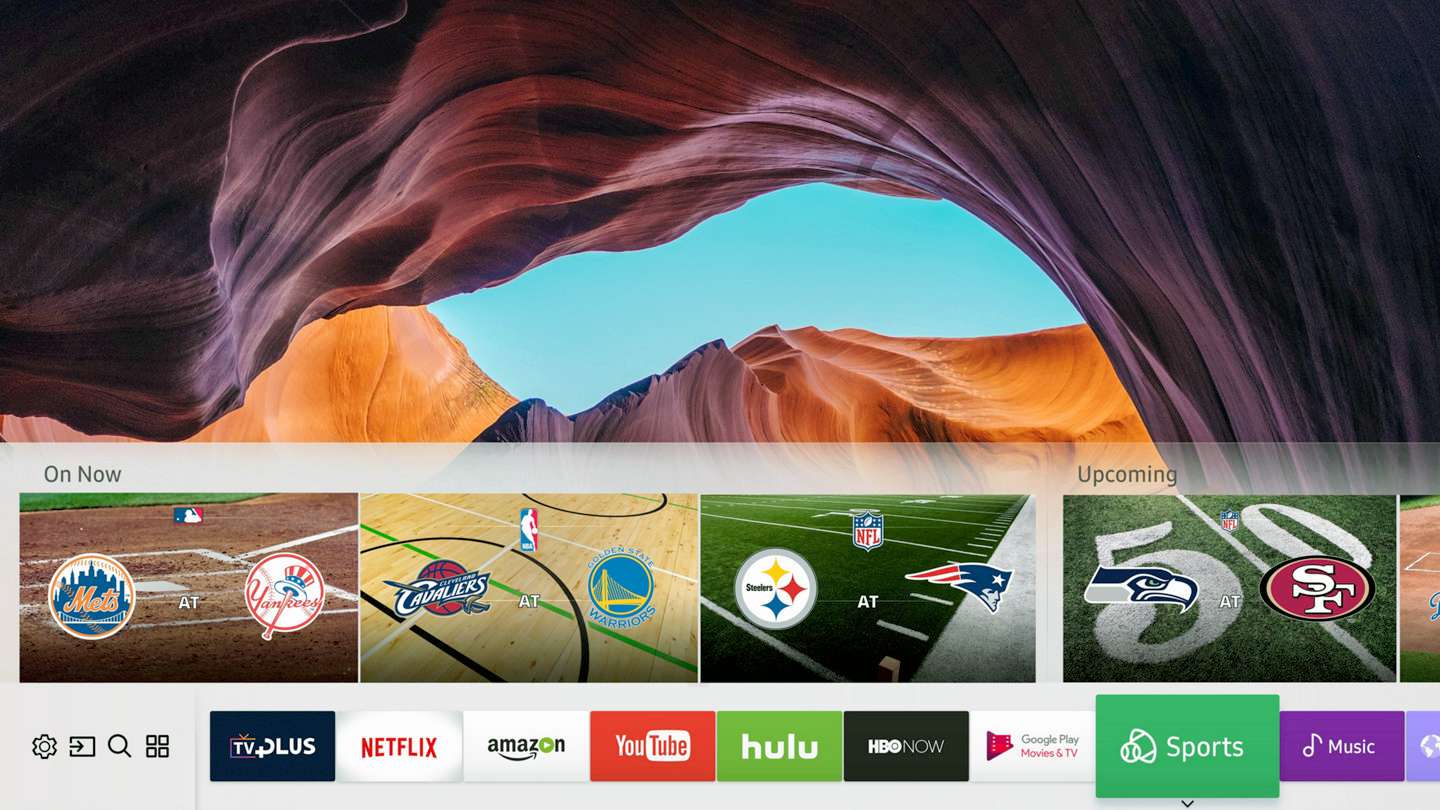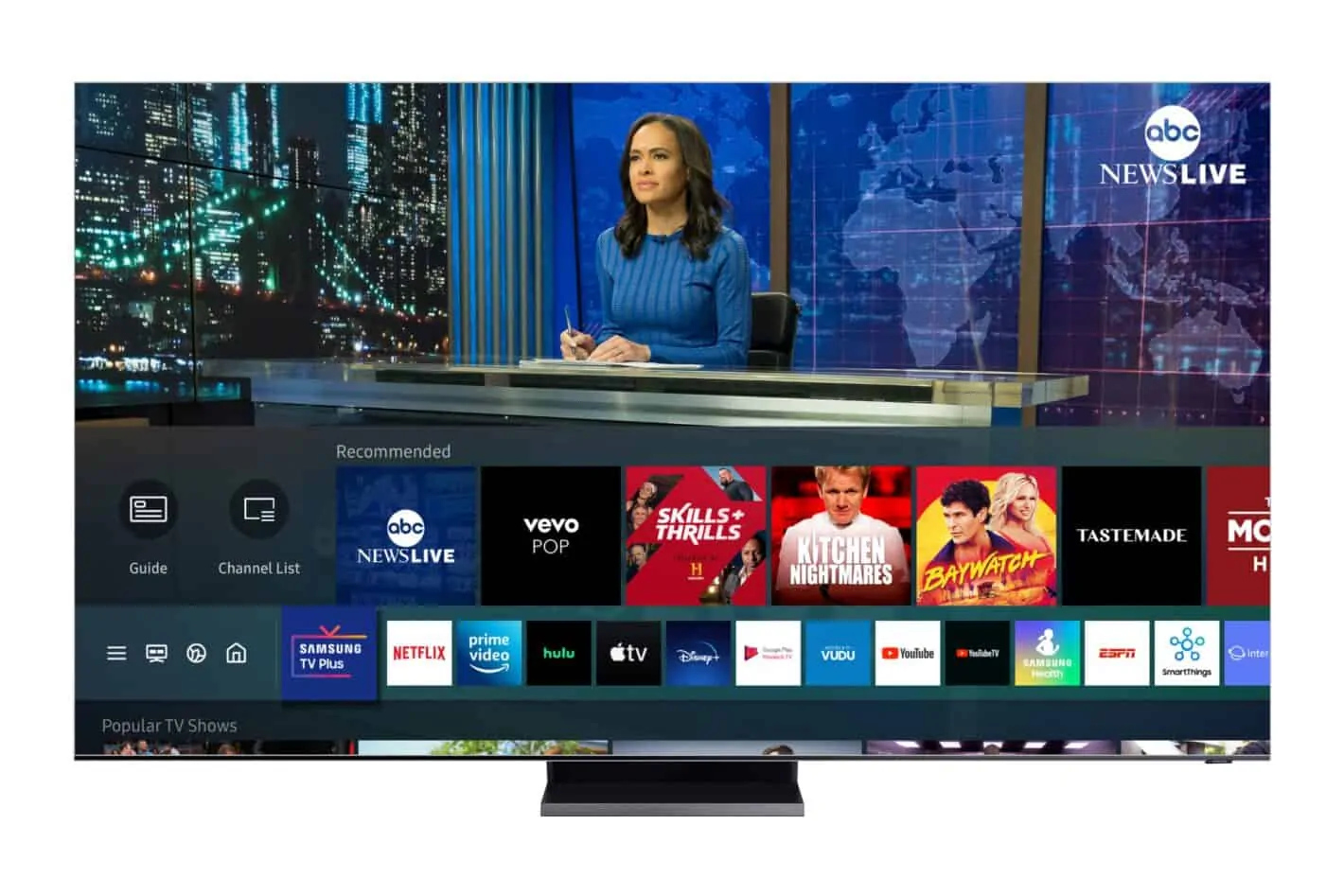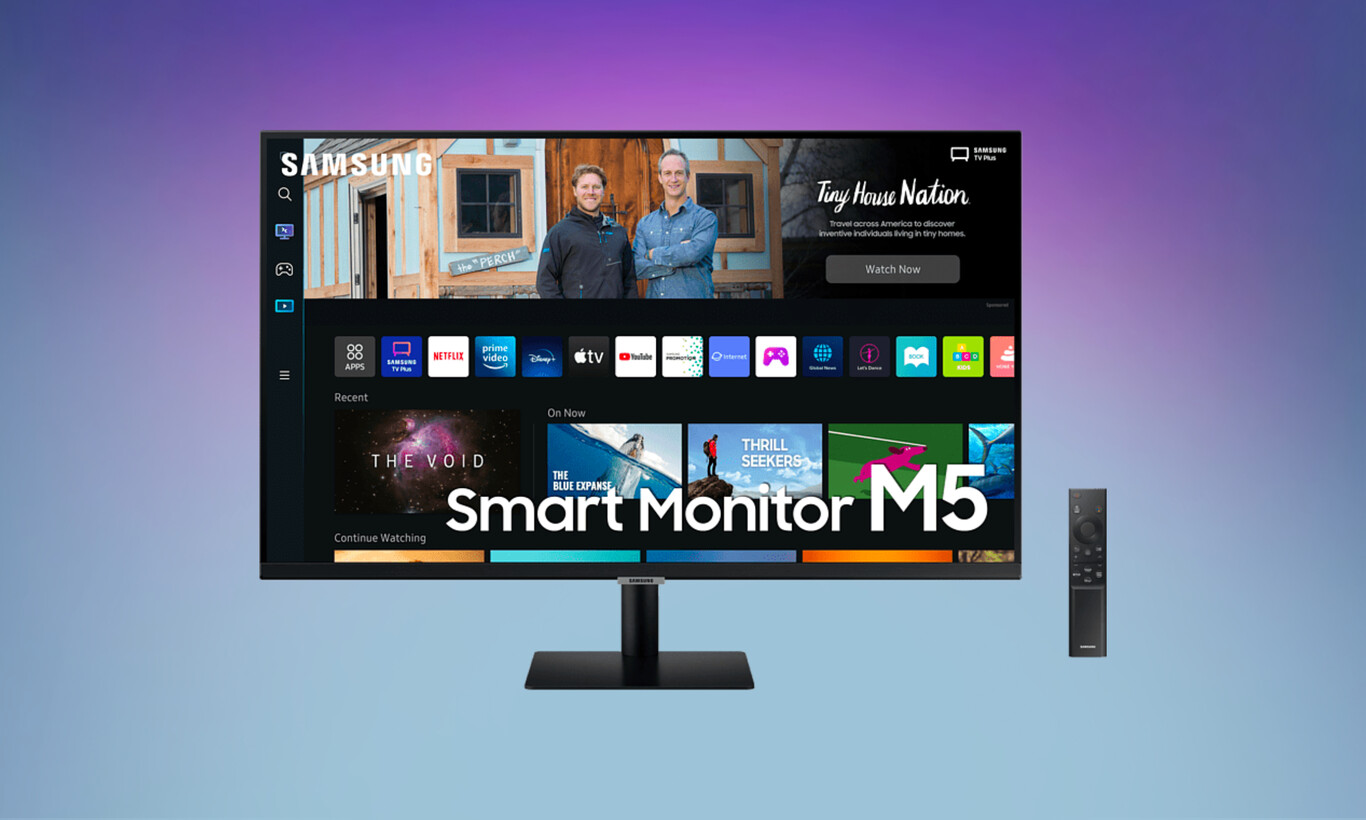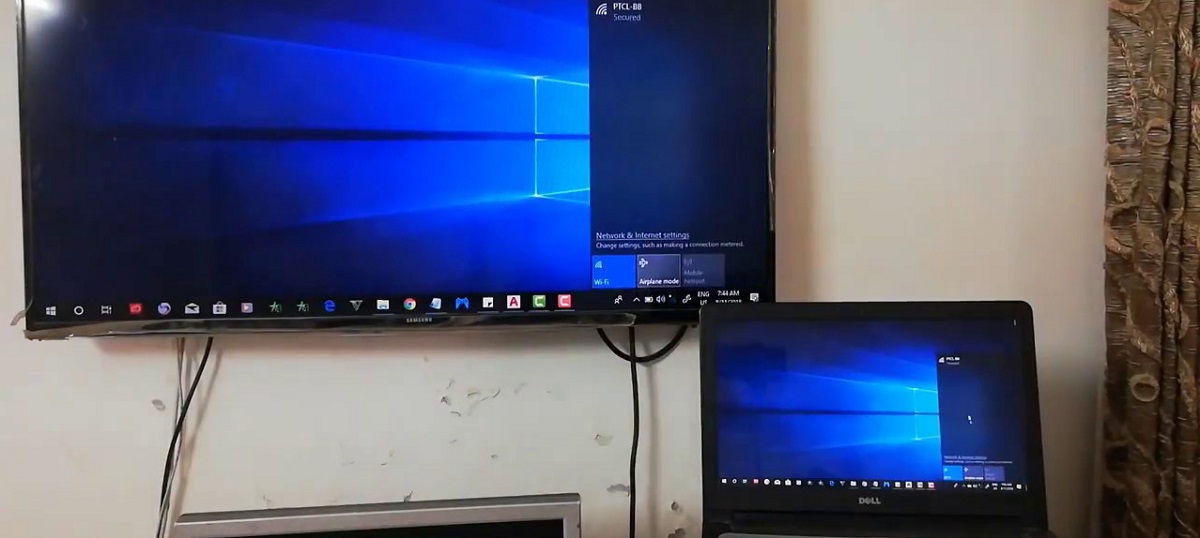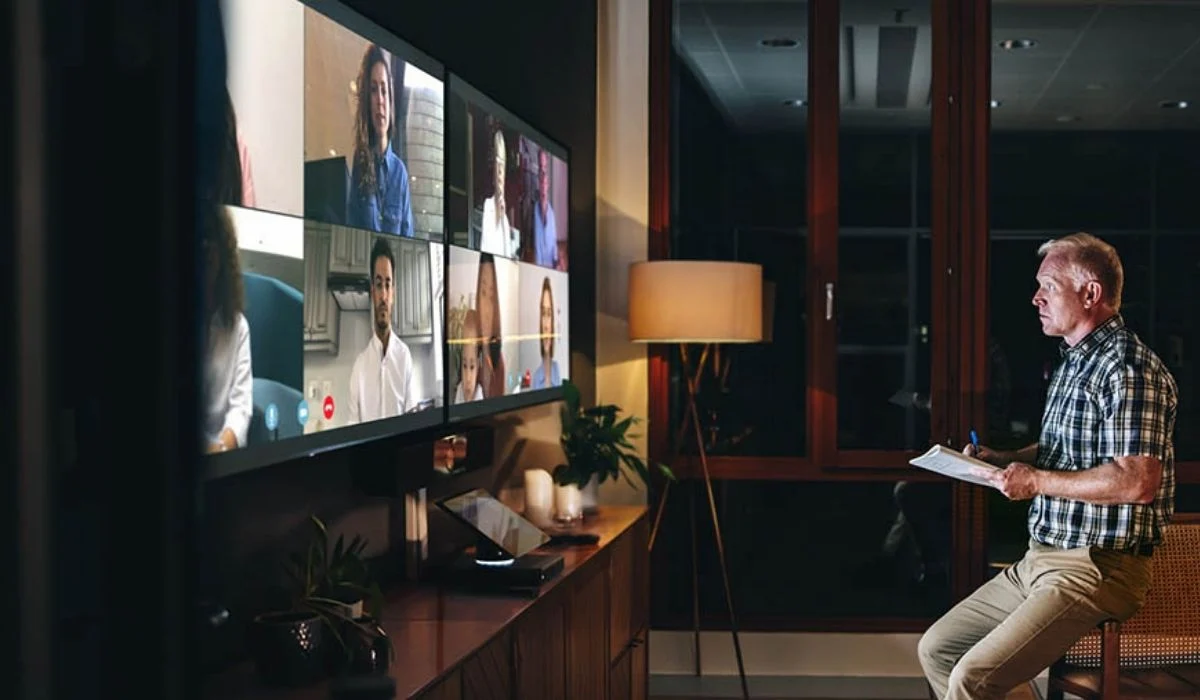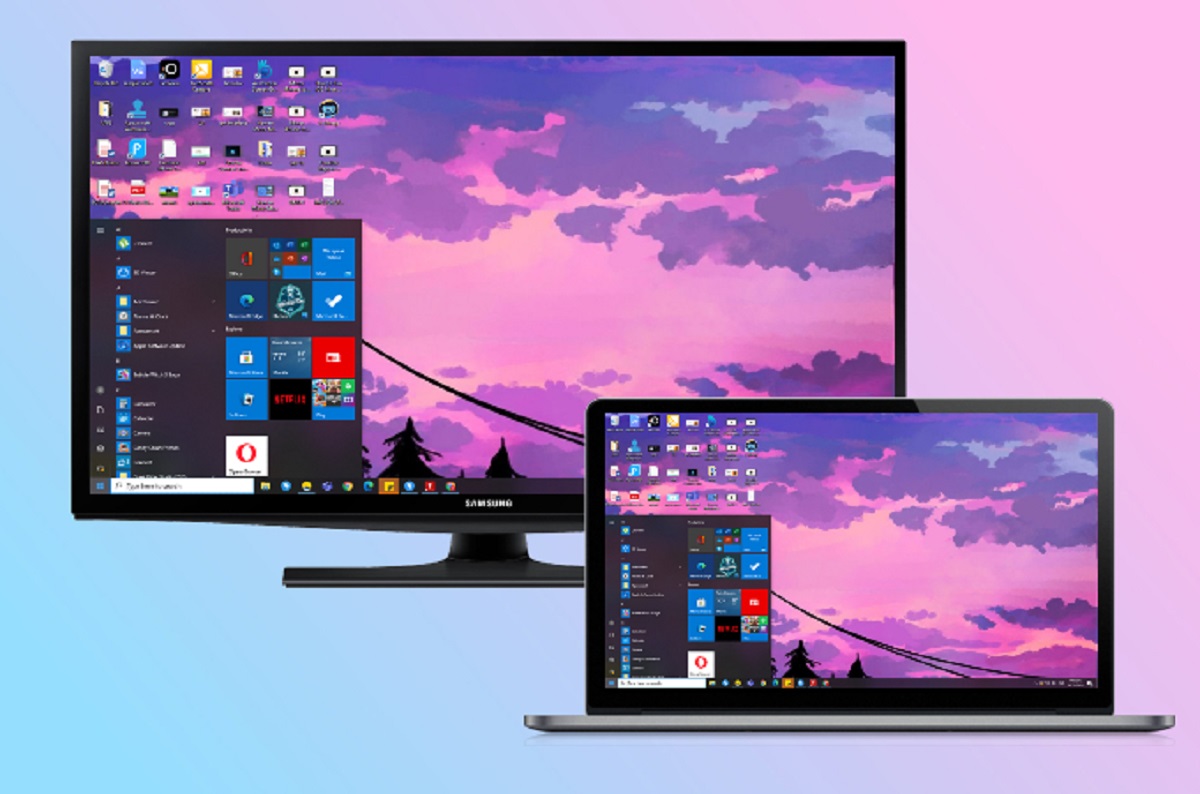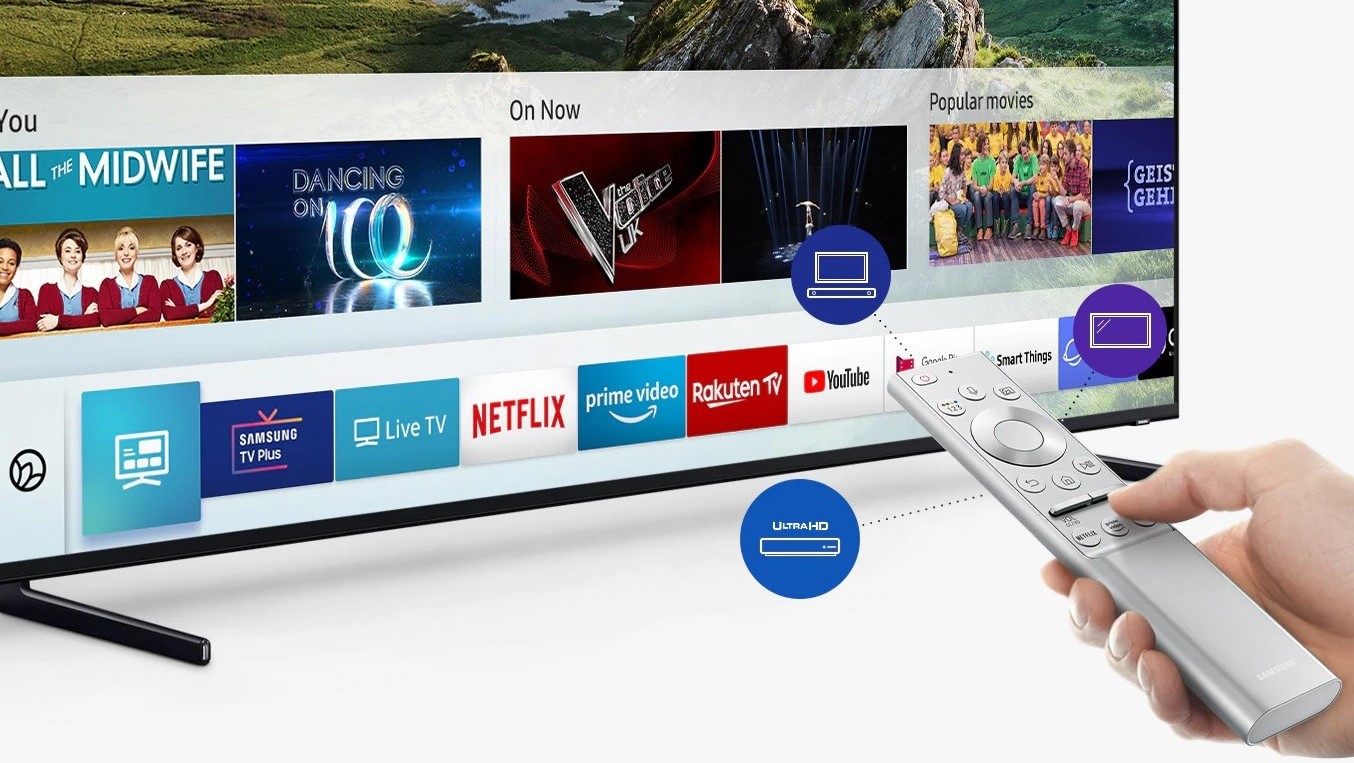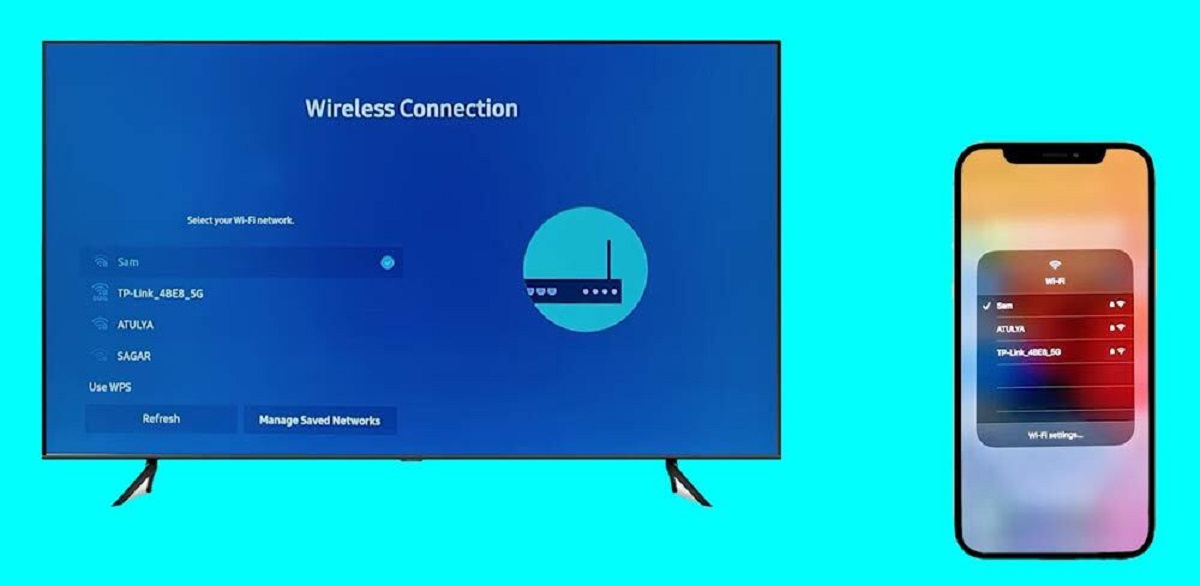Introduction
Welcome to the world of Samsung Smart TVs, where entertainment meets innovation. With advanced features and cutting-edge technology, Samsung Smart TVs offer a seamless and immersive viewing experience like never before. Whether you’re a tech-savvy individual or a casual user, this guide will walk you through the essential steps to operate your Samsung Smart TV with ease and maximize your enjoyment.
Samsung Smart TVs combine the best of both worlds – traditional television and internet connectivity. Gone are the days of flipping through countless channels or relying solely on DVDs. With a Samsung Smart TV, you can access a wide range of apps, stream your favorite shows and movies, and even surf the web, all from the comfort of your couch.
In this comprehensive guide, we will cover everything you need to know to get started with your Samsung Smart TV. From setting up your TV and connecting it to the internet, to navigating through the intuitive interface and exploring the numerous features and functionalities, this guide will be your go-to resource.
Whether you’re a movie buff looking to stream the latest blockbusters, a sports enthusiast who wants to catch every game in high definition, or a gamer searching for an immersive gaming experience, your Samsung Smart TV has got you covered.
So, grab your remote control and get ready to unlock the full potential of your Samsung Smart TV. Let’s dive in and discover how to make the most of this incredible entertainment hub.
Setting Up Your Samsung Smart TV
Before you can start enjoying the vast array of features offered by your Samsung Smart TV, you need to complete the initial setup process. Here’s a step-by-step guide on how to set up your TV:
- Unpack Your TV: Carefully unpack your Samsung Smart TV and place it on a stable and level surface. Ensure that you have all the necessary components, including the remote control and power cord.
- Connect the Power Cord: Plug the power cord into an electrical outlet and connect it to the back of your TV. Ensure that the cord is securely inserted.
- Connect to the Antenna/Cable: If you’re using an antenna or cable connection, connect the corresponding cable to the TV’s antenna/cable input. Secure the connection properly to ensure optimal signal reception.
- Turn on the TV: Press the power button located on the TV or use the remote control to turn on your Samsung Smart TV. Follow the on-screen instructions to proceed.
- Select Language and Region: Choose your preferred language and region from the displayed options. This setting will determine the language used in the TV’s menus and settings.
- Connect to Wi-Fi: To enjoy the full benefits of a Smart TV, connecting to the internet is essential. Navigate to the network settings and select your Wi-Fi network. Enter the password if prompted and establish a successful connection.
- Update Software: It is important to keep your TV’s software up to date to ensure smooth performance and access to the latest features. Check for software updates in the TV’s settings and follow the on-screen instructions to install any available updates.
- Agree to Terms and Conditions: Read and agree to the terms and conditions, privacy policy, and any other agreements presented on the screen. This step enables you to access the full functionality of the Smart TV.
- Perform Initial Channel Scan: If you’re using an antenna connection, perform an initial channel scan to detect and store all available channels. This step ensures that you can easily switch between channels using the TV’s remote control.
- Optional External Devices: If you have any external devices such as gaming consoles or Blu-ray players, connect them to the TV using the appropriate cables. Refer to the device’s instructions for specific connection details.
Once you have completed these steps, your Samsung Smart TV is all set up and ready to use. Take a moment to familiarize yourself with the remote control and the TV’s interface. In the next sections, we will explore how to navigate the home screen, connect to the internet, and access various apps and features.
Navigating the Home Screen
The home screen of your Samsung Smart TV serves as your portal to all the entertainment and features it offers. It provides quick and easy access to your favorite apps, TV shows, movies, and more. Here’s how to navigate the home screen:
1. Home Button: The home button, usually located on your remote control, is the gateway to the home screen. Pressing it will take you back to the main screen from any other menu or app.
2. App Bar: Located at the bottom or side of the screen, the app bar displays a list of popular apps. Navigate through this bar using the arrow keys on your remote control.
3. App Tiles: The home screen is populated with app tiles that represent different applications. Use the arrow keys to move the focus to a specific app tile and press the enter or OK button to launch the app.
4. Recommendations: Samsung Smart TVs provide personalized recommendations based on your viewing habits. These recommendations appear on the home screen and suggest content that you may enjoy. Scroll through the recommendations using the arrow keys.
5. Quick Access Menu: Press the up or down arrow button to open the quick access menu. This menu allows you to access various settings, including picture and sound settings, network settings, and more.
6. Search: If you’re looking for a specific app or content, use the search function. Select the search icon on the home screen and enter your search term using the on-screen keyboard.
7. Customizing the Home Screen: You can customize the home screen by rearranging the app tiles or removing apps that you don’t use frequently. To do this, simply navigate to the app tile, press and hold the enter or OK button, and choose the desired option from the context menu.
Navigating the home screen of your Samsung Smart TV is intuitive and user-friendly. Spend some time exploring the available apps and features to make the most of your entertainment experience. In the next sections, we will learn how to use the remote control, connect to the internet, and install and manage apps.
Using the Remote Control
The remote control is your key to navigating and controlling your Samsung Smart TV. Understanding its functions and features will enable you to effortlessly navigate menus, change settings, and access your favorite content. Here’s a breakdown of how to use the remote control:
1. Navigation: The arrow keys on the remote control allow you to navigate menus, move between options, and select items. Use the up, down, left, and right arrows to move the on-screen cursor.
2. OK/Enter Button: The OK or Enter button in the center of the arrow keys is used to select an option or enter a menu. Press this button to confirm your selection.
3. Back/Return Button: The back or return button lets you navigate back to the previous menu or screen. It is useful when you want to go back without selecting a new option.
4. Home Button: The home button, as mentioned earlier, takes you back to the home screen. Pressing it will return you to the main screen from any other menu or app.
5. Volume and Channel Controls: The remote control features dedicated volume and channel buttons. Use these buttons to adjust the volume or switch channels when watching live TV.
6. Power Button: The power button is used to turn the TV on and off. Pressing it will power the TV on or put it into standby mode.
7. Numeric Keypad: The remote control includes a numeric keypad that allows you to enter specific channel numbers or use it for other functions depending on the context.
8. Smart Hub Button: Pressing the Smart Hub button will take you directly to the Smart Hub screen, where you can access all your installed apps and additional features.
9. Source Button: The source button comes in handy if you want to switch between different input sources, such as HDMI, USB, or AV.
10. Voice Control (if available): Some Samsung Smart TVs offer voice control functionality. If your TV has this feature, you can use the voice button on the remote control to issue voice commands and control your TV through speech.
Mastering the functions of the remote control will enhance your TV viewing experience. Experiment with the different buttons and familiarize yourself with how they work. In the following sections, we will explore how to connect your TV to the internet, install and manage apps, and customize picture and sound settings.
Connecting to the Internet
Connecting your Samsung Smart TV to the internet opens up a world of possibilities, allowing you to stream content, browse the web, and explore a variety of online apps and services. Here’s how to connect your TV to the internet:
1. Wi-Fi Connection: Most Samsung Smart TVs have built-in Wi-Fi capabilities, allowing you to connect wirelessly to your home network. To connect, navigate to the network settings on your TV’s menu and select your Wi-Fi network from the available options. Enter the network password if prompted, and your TV will establish a connection.
2. Wired Ethernet Connection: If you prefer a wired connection for a more stable and reliable connection, you can connect your TV to your router using an Ethernet cable. Simply plug one end of the cable into the Ethernet port on the back of your TV and the other end into an available Ethernet port on your router.
3. Network Settings: Once connected, you may need to adjust some network settings to optimize your TV’s internet performance. In the network settings menu, you can configure the IP settings, DNS server, and proxy settings if required. Most users will not need to change these settings unless instructed to do so by their internet service provider.
4. Test the Connection: After connecting to the internet, it’s essential to test the connection. Use the built-in network test feature on your TV or navigate to a streaming app or web browser to ensure that you have a stable and functioning internet connection.
5. Advanced Connection Options: If you’re experiencing connectivity issues or have specific network requirements, Samsung Smart TVs offer a range of advanced connection options. These include manual IP addressing, MAC address filtering, and VPN setup. Refer to the TV’s user manual or Samsung support website for detailed instructions on these advanced settings.
Once your Samsung Smart TV is connected to the internet, you can start enjoying the full range of streaming services, apps, and online features. From streaming your favorite movies and TV shows to browsing the web and accessing social media, your TV becomes a powerful entertainment center.
In the next sections, we will explore how to install and manage apps, adjust picture and sound settings, and discover additional features offered by your Samsung Smart TV.
Installing and Managing Apps
One of the advantages of owning a Samsung Smart TV is the ability to customize your entertainment experience by installing and managing apps. With a wide selection of apps available, you can personalize your TV with the content and services that matter to you. Here’s how to install and manage apps on your Samsung Smart TV:
1. Smart Hub: The Smart Hub is the central hub for all your apps and content. To access it, press the Smart Hub button on your remote control. Navigate through the different categories using the arrow keys and select the App Store.
2. App Categories: The App Store is organized into various categories, such as movies, TV shows, games, lifestyle, and more. Browse through the categories to find the apps that interest you. You can also use the search function to find a specific app.
3. App Installation: Once you find an app you want to install, select it and choose Install. The app will start downloading and installing in the background. You can monitor the progress of the installation on the screen.
4. App Launch: After installation, the app will appear in the Apps section of the Smart Hub. You can launch it by selecting the app tile and pressing the enter or OK button on your remote control. Some apps may require you to create an account or log in to access their content.
5. App Management: To manage your installed apps, go to the Apps section of the Smart Hub. Here, you can rearrange the app tiles, remove unwanted apps, or update the apps to their latest versions. Simply navigate to the app tile, press and hold the enter or OK button, and select the relevant option from the context menu.
6. App Recommendations: Samsung Smart TVs also provide app recommendations based on your viewing habits. These recommendations appear on the home screen and suggest apps that you may find interesting. Explore these recommendations to discover new apps.
7. Updating Apps: It’s crucial to keep your installed apps up to date to ensure optimal performance and access to the latest features. To update your apps, go to the Apps section of the Smart Hub and navigate to the Updates tab. Select the app that requires an update and choose Update.
By installing and managing apps on your Samsung Smart TV, you can customize your entertainment experience to suit your preferences. Whether you’re into streaming services, games, fitness apps, or news apps, the Samsung App Store has something for everyone.
In the upcoming sections, we will delve into adjusting picture and sound settings, exploring the Smart Hub, and leveraging additional features provided by your Samsung Smart TV.
Adjusting Picture and Sound Settings
To enhance your viewing and audio experience, your Samsung Smart TV offers a range of customizable picture and sound settings. Fine-tuning these settings allows you to optimize the visual and audio quality to your liking. Here’s how to adjust the picture and sound settings on your TV:
1. Picture Settings: To access the picture settings, navigate to the Home Menu using the remote control and select the Picture option. Here, you can adjust settings such as brightness, contrast, color saturation, sharpness, and more. Experiment with these settings to find the optimal balance that suits your preferences.
2. Preset Picture Modes: Samsung Smart TVs often have preset picture modes tailored for specific content types, such as Standard, Dynamic, Movie, or Game modes. These modes automatically adjust the picture settings to enhance the viewing experience based on the content. Select the appropriate mode according to the type of content you’re watching.
3. Sound Settings: To access the sound settings, go to the Home Menu and select the Sound option. Here, you can adjust settings such as volume, equalizer, balance, and even enable virtual surround sound for a more immersive audio experience. Play around with these settings to find the sound profile that suits your preferences.
4. Audio Output: If you have external speakers or a home theater system connected to your TV, you can choose the audio output settings. Go to the Sound menu, navigate to the Sound Output option, and select the desired audio output, such as TV speakers or external speakers, depending on your setup.
5. Advanced Audio Features: Samsung Smart TVs often offer additional audio features, such as dialogue enhancement, sound mode optimization, and audio delay adjustments for better lip-syncing. Explore the advanced audio settings section to take advantage of these features and further enhance your audio experience.
6. Resetting Picture and Sound Settings: In case you want to start fresh or revert back to the default settings, you can reset the picture and sound settings to their original values. Look for the Reset or Default option in the picture or sound settings menu and select it to restore the settings to their factory presets.
Take the time to adjust the picture and sound settings based on your individual preferences and the content you’re watching. By fine-tuning these settings, you can create a personalized and immersive viewing experience on your Samsung Smart TV.
In the upcoming sections, we will explore the Smart Hub, streaming content and services, screen mirroring and sharing, and using voice and gesture commands with your Samsung Smart TV.
Exploring the Smart Hub
The Smart Hub is the central hub of your Samsung Smart TV, providing easy access to a wide range of apps, services, and additional features. This feature-rich platform allows you to personalize your TV experience and discover new content. Here’s how to make the most out of the Smart Hub:
1. Accessing the Smart Hub: Press the Smart Hub button on your remote control to launch the Smart Hub. The Smart Hub screen will display a variety of categories and featured apps.
2. App Categories: The Smart Hub is organized into different categories, such as Videos, Music, Sports, Games, and more. Explore these categories to discover apps and content related to your interests.
3. Featured Apps: The Smart Hub highlights featured apps that are popular or recommended for you. Explore these apps to find new services or content that you may enjoy.
4. App Store: The Smart Hub includes an App Store where you can browse and download a wide range of apps. Visit the App Store to explore apps in different categories, including entertainment, news, lifestyle, education, and more.
5. Recommended Content: The Smart Hub analyzes your viewing habits and recommends personalized content based on your preferences. These recommendations appear on the Smart Hub screen and suggest shows, movies, or other content you may be interested in.
6. Customizing the Smart Hub: You can customize the layout of the Smart Hub to suit your preferences. Rearrange the app tiles by selecting and dragging them to your desired position. Remove unwanted apps by selecting the app and choosing the Delete or Remove option.
7. Recent Apps: The Smart Hub keeps track of the apps you’ve recently used, making it easier to access them again. Navigate to the Recent Apps section to quickly launch the apps you’ve recently used without having to search for them.
8. Additional Features: The Smart Hub may offer additional features depending on your TV model and region. These features can range from social media integration to weather forecasting apps or even voice control functionality. Explore the various sections of the Smart Hub to discover these additional features.
The Smart Hub is your gateway to a world of entertainment, information, and services. Take some time to explore the categories, featured apps, and customized content recommendations. In the following sections, we will delve into streaming content and services, screen mirroring and sharing, and using voice and gesture commands with your Samsung Smart TV.
Streaming Content and Services
One of the major highlights of owning a Samsung Smart TV is the ability to stream a wide range of content and access various streaming services directly on your TV. From movies and TV shows to music and live sports, your Smart TV offers a plethora of options for your entertainment needs. Here’s how to make the most of streaming content and services on your Samsung Smart TV:
1. Pre-installed Apps: Your Smart TV comes with pre-installed apps, such as Netflix, Hulu, Amazon Prime Video, YouTube, and more. These apps allow you to stream a vast library of movies, TV shows, and original content. Simply navigate to the app using the remote control and start streaming.
2. Installing Additional Apps: The Smart Hub’s App Store provides access to a wide range of streaming apps beyond the pre-installed ones. Explore the App Store to find and install apps for different streaming services, including Disney+, HBO Max, Spotify, and many others.
3. Subscription Services: Many streaming services require a subscription to access their content. If you already have a subscription to a streaming service, you can log in to the app using your credentials and start enjoying the content. If not, consider signing up for the services that align with your preferences.
4. Live TV Streaming: Some streaming apps, such as Sling TV, Hulu + Live TV, or YouTube TV, offer live TV streaming options. These services allow you to access a wide range of live channels, including news, sports, and entertainment, directly on your Smart TV.
5. Content Recommendations: Streaming apps on your Smart TV often provide personalized recommendations based on your viewing history. These recommendations suggest new shows, movies, or genres that you might enjoy. Take advantage of these suggestions to discover new content.
6. User Profiles: Many streaming apps allow you to create user profiles within a single account. This feature enables each member of your household to have their own personalized recommendations and watchlists. Create individual profiles for yourself and your family members to tailor the streaming experience to each person’s preferences.
7. Casting and Screen Mirroring: If you have a compatible smartphone or tablet, you can cast or mirror the content from these devices to your Smart TV. This allows you to enjoy apps and content from your mobile devices on a larger screen. Simply use the casting or screen mirroring feature on your mobile device and select your Smart TV as the target device.
Streaming content and services give you the flexibility to watch what you want, when you want it. Whether you’re catching up on the latest shows, watching movies, or listening to music, your Samsung Smart TV provides a vast array of options to cater to your streaming preferences.
In the upcoming sections, we will explore screen mirroring and sharing features, using voice and gesture commands, and connecting external devices to your Samsung Smart TV.
Screen Mirroring and Sharing
Samsung Smart TVs offer a variety of screen mirroring and sharing options that allow you to display content from your mobile devices or computers on the larger screen of your TV. Whether you want to view photos, watch videos, or give a presentation, screen mirroring and sharing features make it easy to share content seamlessly. Here’s how to utilize screen mirroring and sharing on your Samsung Smart TV:
1. Smart View (Samsung Devices): If you own a Samsung smartphone or tablet, you can use the Smart View feature to mirror your device’s screen directly on your TV. Open the Smart View app on your mobile device and select your TV from the list of available devices. The mobile device’s screen will be mirrored on your Smart TV.
2. Screen Mirroring (Android): For Android devices that support screen mirroring, access the settings menu on your mobile device and look for “Screen Mirroring” or “Cast Screen” options. Select your Smart TV from the list of available devices, and your mobile device’s screen will be mirrored on the TV.
3. AirPlay (Apple Devices): If you have an iPhone, iPad, or Mac, you can use the AirPlay feature to mirror your device’s screen on your Smart TV. Ensure that your iOS device and Smart TV are connected to the same Wi-Fi network. Swipe up from the bottom of the screen on your iOS device to access the Control Center, tap on “Screen Mirroring,” and select your Smart TV from the list of available devices.
4. SmartThing App: The SmartThing app allows you to connect and control multiple devices, including your Smart TV, from a single app. Install the SmartThing app on your mobile device and follow the instructions to connect your TV. Using the app, you can easily share media and control your TV’s settings.
5. DLNA: If you have a DLNA-compatible device, you can enable DLNA on your Samsung Smart TV to stream content from compatible devices connected to the same network. Access the TV’s settings, find the DLNA option, and ensure it is enabled. Then, you can access media on your connected devices directly from the TV’s media player or a compatible app.
6. USB Multimedia: Another way to share content on your Smart TV is through USB. Simply transfer photos, videos, or music files onto a USB drive and plug it into the USB port on your TV. Use the TV’s media player to access and play the content directly from the USB drive.
Whether it’s sharing vacation photos, watching videos with friends, or conducting presentations, screen mirroring and sharing features on your Samsung Smart TV make it convenient to enjoy content from various devices on a larger screen. Take advantage of these features to enhance your viewing and sharing experience.
Finally, in the next section, we will explore how to utilize voice and gesture commands to control your Samsung Smart TV.
Using Voice and Gesture Commands
Controlling your Samsung Smart TV with voice and gesture commands adds a new level of convenience and interactivity to your viewing experience. By simply using your voice or making hand gestures, you can navigate menus, launch apps, adjust settings, and more. Here’s how to utilize voice and gesture commands with your Samsung Smart TV:
1. Voice Commands: Many Samsung Smart TVs feature built-in voice recognition technology. To activate this feature, press the dedicated voice control button on your remote control or say a wake word to prompt the TV to listen. You can then issue voice commands, such as “Open Netflix,” “Change the channel to ESPN,” or “Turn up the volume.” The TV will perform the requested action based on your voice command.
2. Voice Assistants: Some Samsung Smart TVs support popular voice assistants like Bixby, Google Assistant, or Amazon Alexa. With these voice assistants, you can control your TV using voice commands and access a wider range of services and features, including checking the weather, controlling other smart home devices, and getting answers to questions.
3. Gesture Control: Certain Samsung Smart TVs offer gesture control capabilities, allowing you to navigate the TV’s menus and perform actions by making hand gestures in front of the TV’s built-in camera or using a compatible gesture control accessory. You can swipe, point, or make specific gestures to control various functions, such as selecting an app, adjusting the volume, or navigating through menus.
4. Remote Control Integration: In addition to using voice and gesture commands, some Samsung Smart TVs allow you to use your smartphone or tablet as a remote control. Download the respective TV remote app and connect it to your Smart TV. This feature provides an extra level of convenience, as you can control your TV using your mobile device’s touch screen and keyboard.
5. Training and Personalization: Some voice and gesture control features may require initial training to understand your specific voice or gestures better. Take the time to follow the provided instructions to train the TV for better accuracy and recognition. This process helps personalize the experience and ensures that the commands and gestures are accurately detected and executed.
Using voice and gesture commands adds a hands-free and intuitive element to operating your Samsung Smart TV. Whether you prefer to give voice commands or make gestures, these features make it easier and more enjoyable to navigate menus, access apps, and control various TV functions.
Lastly, in the next section, we will explore how to connect external devices to your Samsung Smart TV.
Connecting External Devices
Connecting external devices to your Samsung Smart TV allows you to expand its functionality and enjoy content from various sources. Whether it’s gaming consoles, Blu-ray players, sound systems, or streaming devices, connecting external devices enhances your entertainment experience. Here’s how to connect external devices to your Samsung Smart TV:
1. HDMI Cables: One of the simplest ways to connect external devices is through HDMI cables. Most modern TVs and devices support HDMI connectivity. Simply plug one end of the HDMI cable into the HDMI port on your TV and the other end into the HDMI output of your device, such as a gaming console or Blu-ray player.
2. USB Devices: Many Samsung Smart TVs feature USB ports that allow you to connect USB devices, such as flash drives or external hard drives. By plugging in the USB device, you can access and play various media files, including photos, videos, and music directly from the TV’s media player.
3. Optical or HDMI ARC: If you have a sound system or home theater system, connecting it to your Samsung Smart TV can enhance the audio experience. Use an optical cable or an HDMI cable with ARC (Audio Return Channel) capability to connect the audio output of your TV to the audio input of your sound system. This setup enables you to enjoy audio from your TV through the external speakers.
4. Streaming Devices: If you prefer using a specific streaming device, such as a Roku, Apple TV, or Fire TV Stick, you can connect it to your Samsung Smart TV using an available HDMI port. This setup allows you to access additional streaming services or features that may not be available directly on your TV.
5. Gaming Consoles: For gaming enthusiasts, connecting a gaming console to your Samsung Smart TV provides a high-quality gaming experience. Connect your console using an HDMI cable and select the corresponding HDMI input on your TV. This setup allows you to play games in stunning high-definition on a large screen.
6. Other Devices: Apart from the mentioned devices, you can connect various other external devices to your Samsung Smart TV. This includes DVD players, digital cameras, laptops, and more. Refer to the device manufacturer’s instructions for the specific connection details.
Connecting external devices to your Samsung Smart TV expands your entertainment options and lets you enjoy content from multiple sources. Whether it’s gaming, streaming, or accessing media files, connecting external devices adds versatility to your viewing experience.
Finally, in the last section, we will explore common troubleshooting tips for resolving common issues with your Samsung Smart TV.
Troubleshooting Common Issues
While Samsung Smart TVs offer a seamless and immersive viewing experience, occasional technical issues may arise. Here are some common issues you may encounter with your Samsung Smart TV and how to troubleshoot them:
1. No Picture or No Sound: If you’re experiencing a complete loss of picture or sound, first check that all the cables are properly connected. Ensure that the TV is turned on and the correct input source is selected. If the issue persists, try power cycling the TV by unplugging it from the power source for a minute and then plugging it back in. For sound-related issues, ensure that the volume is not muted and the audio settings are correctly configured.
2. Poor Picture Quality: If you notice a degradation in picture quality, first check your TV’s picture settings. Ensure that the brightness, contrast, and sharpness settings are properly adjusted and that any picture enhancement features, like motion smoothing, are set to your preference. If the issue persists, check the source of the content (e.g., cable box, streaming device) for any resolution or signal issues.
3. Internet Connectivity Problems: If your Smart TV is having trouble connecting to the internet, first check that your Wi-Fi network is functioning properly. Ensure that you are within range of the Wi-Fi router and that the network name and password are correctly entered. You can also try restarting your router and TV to clear any connection issues. If the problem persists, consider connecting your TV directly to the router using an Ethernet cable for a more stable connection.
4. App Issues: If you’re experiencing difficulties with a specific app on your Smart TV, start by ensuring that the app is fully updated to the latest version. Go to the app’s settings or the Smart Hub’s Updates section to check for any available updates. If the issue persists, try deleting and reinstalling the app. If the problem continues, contact the app’s support team for further assistance.
5. Remote Control Problems: If your remote control is not working properly, first check that the batteries are correctly inserted and have sufficient charge. Make sure there are no obstructions between the remote and the TV’s infrared sensor. If the issue persists, try re-pairing the remote control with your TV. Refer to your TV’s user manual or the manufacturer’s website for specific instructions on how to do this.
6. TV Not Turning On or Random Restarts: If your TV is not turning on or if it restarts unexpectedly, check the power source and ensure that it is securely connected. Try unplugging the TV from the power source for a few minutes and then plugging it back in. If the problem continues, it may be a hardware issue, and you should contact Samsung’s customer support for assistance.
Remember to consult your TV’s user manual or the manufacturer’s website for specific troubleshooting steps and recommendations for your model. If the issue persists or if you encounter any other problems, reaching out to Samsung’s customer support will provide you with expert assistance specific to your TV’s model and software.
By understanding and troubleshooting common issues, you can resolve technical problems and ensure a smooth and enjoyable experience with your Samsung Smart TV.
Conclusion
Congratulations! You have now gained a comprehensive understanding of how to operate your Samsung Smart TV. From setting it up and navigating the home screen to connecting to the internet, installing apps, adjusting picture and sound settings, exploring the Smart Hub, streaming content, utilizing voice and gesture commands, connecting external devices, and troubleshooting common issues, you are well-equipped to make the most of your Smart TV experience.
With its advanced features and endless entertainment possibilities, your Samsung Smart TV offers a world of convenience and enjoyment. Whether you’re streaming your favorite shows and movies, playing games, browsing the web, or connecting external devices, your TV becomes the ultimate entertainment hub right in your living room.
Remember to personalize your TV by customizing settings, arranging app tiles, and exploring different apps and features that suit your tastes and preferences. Stay up to date with software updates to ensure optimal performance and access to the latest features and security enhancements.
If you encounter any technical issues or need further assistance, consult the user manual or reach out to Samsung’s customer support, who will be able to provide specialized guidance and troubleshooting specific to your TV model.
Now it’s time to sit back, relax, and enjoy the countless hours of entertainment that your Samsung Smart TV brings to your home. Whether you’re watching your favorite shows, exploring new apps, or immersing yourself in the world of gaming, your Smart TV is ready to deliver an exceptional viewing experience.
Thank you for following this guide, and may your Samsung Smart TV bring you endless hours of enjoyment and entertainment!







